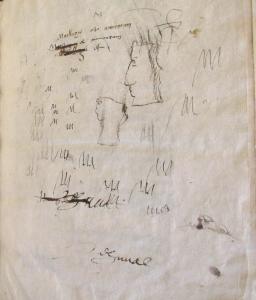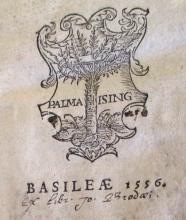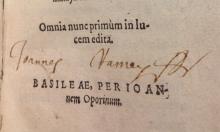In September 2014, I began an internship in the Department of Printed Books and Bindings at the Morgan Library & Museum while studying for a Master’s of Library Science degree with an emphasis on Special Collections. My academic background is in French literature and cultural studies. The department was looking for an intern to work on the Ramey Collection, and I was pleased to arrive in the right place at the right time.
The Morgan purchased most of the collection in 1988–89 en masse from the French family who had owned most of the books since the sixteenth century. Composed primarily of sixteenth-century imprints in French and Latin, the collection offers scholars the remarkable opportunity to encounter a library that was formed organically according to the reading interests of one family.
The nearly 400 books, many of which are still in their original limp parchment bindings, were well-used and well-loved. Using data from a survey performed on the collection by Morgan Adams of the museum’s Thaw Conservation Center, I began to update the catalog records. I was also asked to describe any inscriptions and annotations, which provide another window into the life of these books before and during their time with the Ramey family.
I found previous owners’ signatures, marginalia, and sometimes even drawings. An image of a Gothic-style castle, complete with turrets and flags, was found on the inside cover of La legende des Flamens (PML 125173). The book is a work on medieval history, printed in 1558. Though it is impossible to know what inspired the drawing at the time, I couldn’t help but consider that a medieval castle drawn in a book on medieval history would have already been a nod to history.
The Archeology of Inscriptions and the Used Book Trade
Many of the books I handled were clearly acquired second-hand, an interpretation justified by the non-Ramey inscriptions in the collection. In two extraordinary instances, non-Ramey inscriptions recur within the collection. A 1530 edition of Hieronymus Gebweiler’s Epitome regii ac vetustissimi ortus Sacræ Cæsareæ ac Catholice Maiestatis (PML 125036), pictured here, contains an ownership inscription by an individual named Duval.
The same inscription recurs in Sigmund Gelen’s Castigationes ex vetustorum archetyporum collatione, published in 1536 (PML 125155). No other information is included in the inscription, and it is impossible to tell how and why both books came to be in the Ramey family library. The same is true for another set of common inscriptions, each made by a person identifying himself as Jo. Brodeus. The spelling of the last name varies between the three entries, but each presumably refers to a Jean Brodeau. The first book in the collection to bear a version of this signature is a 1556 edition of Junius Hadrianus’ Animadversorum libri sex (PML 125076), pictured here. The second is the 1583 edition of Janus Gulielmus’ Plautinarum quaestionum commentarius (PML 125156). The inscription occurs for a final time in Laevini Torrentii In C. Suetonii Tranquilli XII Caesares commentarii (PML 125344), written by Laevinus Torrentius and published in 1578.
The presence of these three inscriptions within the collection is tantalizing, though it does not provide enough evidence to draw definite conclusions. These books may have been gifts or purchases, and are probably a very random sample from a larger collection held by Jean Brodeau. The Brodeaus were an illustrious family from Tours, who counted among their members the erudite scholar and Greek commentator, Jean Brodeau (1500–1563). A likely candidate to have owned the Morgan’s book would be his brother’s descendant, Jean Brodeau (1622–1712), who was the seigneur de Candé, de Vaugrigneuse, marquis de Châtres (among other things). Perhaps it is more than just a coincidence that his mother’s name was Duval—the other recurring ownership inscription I found in the Ramey’s collection.
Even when an individual owner cannot be identified, the evidence of their existence adds to the sense of a collection created from both new and used texts.
Reading the Rameys
The presence of contemporary annotations and inscriptions in many of the books in the Ramey Collection testifies to their provenance, as well as to their journey through the family. Reading these inscriptions humanizes their former owners and puts the modern reader in touch with sixteenth-century attitudes toward reading and toward the possession of books.
Though many books have inscriptions made by people who owned and read them before they entered the Ramey collection, others feature inscriptions made by several generations of family members. By far the most common inscription, “Joannes Ramey” is neatly written on the title pages of many works. Interestingly, these books usually do not have annotations within the text. This Jean Ramey, born 25 August 1558 and deceased 1 October 1631, is thought to have been the primary book collector in the family (Cf. Nicholas Pickwoad, "The Interpretation of Binding Structure: an Examination of Sixteenth-Century Bindings in the Ramey Collection in the Pierpont Morgan Library" in The Library, 6th series, 17 [Sept. 1995], pp. 209–249). Nevertheless, his inscriptions are accompanied by many others that were probably made by later members of his family. It is possible that some inscriptions and markings were made by children or adolescents.
My work on the Ramey Collection has been an exciting opportunity to engage with a collection of books that is so intimately connected to the reading interests and practices of the Ramey family. I have loved the chance to get to know them through their books, and to try to understand the ways in which they engaged with them intellectually and materially.







